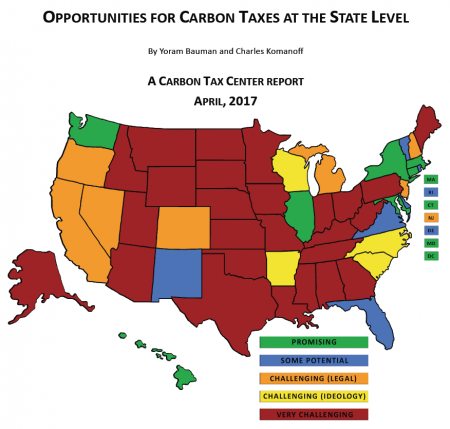May 16, 2017 – A carbon tax block of states is forming in the American Northeast as I write this posting. Rhode Island, Connecticut, and Massachusetts have legislation ready to go to implement carbon taxes within their jurisdictions. They join California with its cap-and-trade, Washington, Hawaii, Illinois, and New York along with District of Columbia as the leaders in combating climate change.
At the federal level, there is no chance to see a price put on carbon for the foreseeable future. But consider that Trump’s avoidance of making tough national decisions usually leads to him favouring the states to do their own bidding, he is, in fact, enabling climate change action at the grassroots level.
Today the U.S. has two cap-and-trade jurisdictions, California and nine northeastern states. But a carbon tax as yet does not appear anywhere. Massachusetts today is probably closest to enabling legislation to pass carbon pricing. Rhode Island and Connecticut are waiting on their neighbour to make the move before they commit. New York is close behind.
The map below accurately paints the current mindset of U.S. state legislators when it comes to carbon pricing. The states close to enabling carbon pricing are painted green, and those moving in the right direction are blue. The rest in yellow, orange and rust appear problematic or are suffering from ideological climate change denial.
In the latest report from the Carbon Tax Center, it sees 17 states as showing promise in the near future of implementing carbon pricing. By near future, it means some time in the next decade. At the same time, the report highlights states opposed. Many in absolute opposition are fossil fuel producers with coal, oil or natural gas a powerful lobby within these jurisdictions.
Does It Only Take One State?
No states those who are implementing carbon pricing policies in jurisdictions elsewhere. They describe implementing carbon pricing in one jurisdiction without others joining in as an unhealthy recipe for economic dislocation. They argue and provide evidence to show that carbon pricing works best when it is spread over a larger population. Multiple state adoption means that a single state’s industries don’t have to absorb the shock of added carbon costs for their products.
In a recent World Bank report describing the carbon pricing experience of countries like Norway, Sweden, Switzerland, France and others, it describes the process of easing into carbon pricing incrementally to allow business to adjust, to find efficiencies, reduce environmental impacts, and to remain competitively healthy. In the report, John Roome, Senior Director, Climate Change, states, “The early evidence tells us that many of the fears policymakers and business leaders have had, about a negative impact of carbon pricing on competitiveness, is likely misplaced.”









